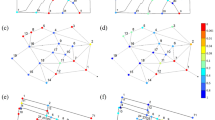Abstract
Metropolitan areas consist of complicated systems of interconnected infrastructures that are highly interdependent. Disruption of one infrastructure may induce disruption in other interconnected ones. The results from analysis of one infrastructure as an independent system are not realistic without considering the behavior of other interconnected infrastructures. Consequently, the study of the interdependencies among critical infrastructures is important for addressing the cascading effects of a failed infrastructure on the entire network to properly model its performance and help the disaster management team in decision making. In this study, the extended Petri net and Markov chain have been used to demonstrate the power and water infrastructure interdependency with a case study of one of the municipal districts of metropolitan Tehran, the capital of Iran. In this research, three cases have been assessed quantitatively: (1) the intra-dependency effects of different components in each network, (2) the interdependency effects between the considered critical infrastructures and (3) the behavior of the water network considering intra- and interdependency, when the power network fails. The analyses show that considering the mentioned interdependencies has a major influence on their performance simulations and assessment of their exact vulnerability. It is concluded that the failure probability of the water network that is dependent on the failed power network is 1.66 of the independent water network in the studied region. Eventually, the results of the research could be used in design, restoration and disaster management planning for safety assessment of critical infrastructures.





Similar content being viewed by others
References
Bobbio A (1990) System modeling with Petri nets. In: Colombia AG, Saiz de Bustamante A (eds) System reliability assessment, pp 102–143
Chang S, Seligson H, Eguchi R (1996) Estimation of the economic impact of multiple lifeline disruption: Memphis light, gas and water division case study (NCEER-96-0011). The Multidisciplinary Center for Earthquake Engineering (MCEER), Buffalo, N.Y
Ching W-K, Ng M (2006) Markov chains: models, algorithms and applications. Springer, New York
Cirado G, Lindemann C (1993) Analysis of deterministic and stochastic Petri nets. Proceeding of the fifth international workshop on Petri nets and performance models (PNPM93). Toulouse, France
Dueñas-Osorio L, Craig JI, Goodno BG (2007a) Seismic response of critical interdependent networks. Earthq Eng Struct Dyn 36(2):285–306
Dueñas-Osorio L, Craig JI, Goodno BG, Bostrom A (2007b) Interdependent response of networked systems. J Infrastructure Syst 13(3):185–194
Fedora PA (2004) Reliability review of North American gas/electric system interdependency. Proceedings of the 37th Hawaii International Conference on System Sciences, IEEE
FEMA (1997) HAZUS 97 technical manual. Federal Emergency Management Agency (FEMA), Washington DC
FEMA (2003) HAZUS MH MR1 technical manual. Federal Emergency Management Agency (FEMA), Washington DC
FEMA (Federal Emergency Management Agency) (2005) HAZUS-MH MR1 technical manual. Federal Emergency Management Agency (FEMA), Washington D. C
Ge Y, Xing X, Cheng Q (2010) Simulation and analysis of infrastructure interdependencies using a Petri net simulator in a geographical information system. Int J Appl Earth Obs Geoinf 12(6):419–430
Gillette J, Fisher R, Peerenboom J (2002) Analyzing water/wastewater infrastructure interdependencies. 6th International Conference on Probabilistic Safety Assessment and Management. San Juan
Grimstead CM, Snell JL (1997) ‘Introduction to probability’. An online textbook, published by American Mathematical Society. Website:http://www.dartmouth.edu/~chance/teaching_aids/books_articles/probability_book/amsbook.mac.pdf
Gursesli O, Desrochers A (2003) Modeling infrastructure interdependencies using Petri nets. IEEE Int Conf Syst Man Cybern 2:1506–1512
Haimes Y, Jiang P (2001) Leontief-based model of risk in complex interconnected infrastructures. J Infrastructure Syst 7(1):1–12
Haimes YY, Horowitz BM, Lambert JH, Santos JR, Lian C, Crowther KG (2005a) Inoperability input-output model for interdependent infrastructure sectors. I: theory and methodology. J Infrastructure Syst 11(2):67–79
Haimes YY, Horowitz BM, Lambert JH, Santos JR, Crowther K, Lian C (2005b) Inoperability input-output model for interdependent infrastructure sectors. II: case studies. J Infrastructure Syst 11(2):80–92
Howard RA (1971) Dynamic probabilistic systems, vol 1. Wiley, NY
JICA (Japan International Cooperation Agency) (2006) The study on water supply system resistant to earthquakes in tehran municipality. Nihon Suido Consultants Co
Karr AF (1990) Markov processes. In: Heyman DP, Sobel MJ (eds) Stochastic models. Handbooks in operations research and management science 2. Elsevier Science Publishers B.V, North-Holland, pp 95–123
Kennedy JG, Snell JL, Thompson GL (1974) Introduction to finite mathematics, 3rd edn. Prentice-Hall, Englewood Cliffs, NJ
Krings A, Oman P (2003) A simple GSPN for modeling common mode failures in critical infrastructures. Proceedings of the 36th Hawaii international conference on system sciences, Hilton Waikoloa Village, Island of Hawaii, Jan 6–9
Luna R, Balakrishnan N, Dagli CH (2011) Post earthquake recovery of a water distribution system: discrete event simulation using colored Petri nets. J Infrastructure Syst 17(1):25–34
Murata T (1989) Petri nets: properties, analysis and applications. Proc IEEE 77(4):541–580
NERC (2004) Gas/electricity interdependencies and recommendations. North American Electric Reliability Council, Princeton, NJ
Peerenboom JP, Fisher RE, Rinaldi SM, Kelly TK (2002) Studying the chain reaction. Electr Perspect 27(1):22–35
Peterson J (1981) Petri net theory and the modeling of systems. Prentice-Hall Inc, N.J
Petri CA (1962) Communicating with Automata. Germany: PhD thesis, Technical University Darmstadt
Ramchandani C (1974) Analysis of asynchronous concurrent systems by timed Petri nets. Massachusetts Institute of technology, Cambridge, MA
Rinaldi SM, Peerenboom JP, Kelly TK (2001) Identifying, understanding, and analyzing critical infrastructure interdependencies. IEEE Control Systems Magazine. December, 11–25
Robert B (2004) A method for the study of cascading effects within lifeline networks. Int J Criti Infrastructures 1(1):86–99
Satumtira G, Dueñas-Osorio L (2010) Synthesis of modeling and simulation methods on critical infrastructure interdependencies research. In: Sustainable and resilient critical infrastructure systems, Springer, Berlin, Heidelberg, pp 1–51
Sultana S, Chen Z (2009) Modeling flood induced interdependencies among hydroelectricity generating infrastructures. J Environ Manag 90(11):3272–3282
Zuberek W (1991) Timed Petri nets: definitions, properties and applications. Microelectro Reliab 31(4):627–644
Author information
Authors and Affiliations
Corresponding author
Rights and permissions
About this article
Cite this article
Omidvar, B., Hojjati Malekshah, M. & Omidvar, H. Failure risk assessment of interdependent infrastructures against earthquake, a Petri net approach: case study—power and water distribution networks. Nat Hazards 71, 1971–1993 (2014). https://doi.org/10.1007/s11069-013-0990-6
Received:
Accepted:
Published:
Issue Date:
DOI: https://doi.org/10.1007/s11069-013-0990-6




